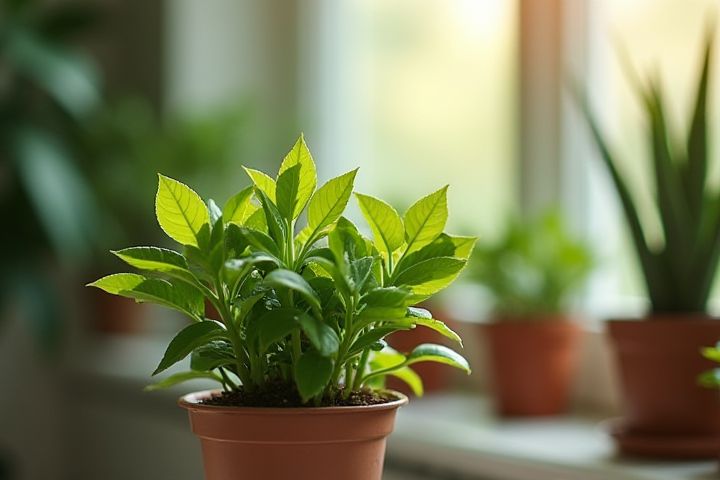
To maximize the light exposure for your house plants, identify the type of light they require: low, medium, or bright indirect light. Position your plants near east-facing windows for gentle morning sunlight, which is ideal for many tropical varieties. South-facing windows provide bright light, suitable for plants like succulents and cacti, while west-facing windows offer intense afternoon sun, beneficial for sun-loving species. If your space lacks natural light, consider using grow lights to supplement and ensure your plants thrive. Regularly rotate your plants to promote even growth and prevent them from leaning towards the light source.
Where To Place House Plants For Light
East-facing windows
East-facing windows provide bright, indirect sunlight during the morning, making them ideal locations for house plants that thrive in such conditions. Positioning your plants within 2-3 feet of the window allows them to receive optimal light while minimizing the risk of sunburn. Species like peace lilies, pothos, and spider plants flourish in this environment, enjoying the gentle morning rays. To ensure a balanced growth, rotate your plants every few weeks for even exposure to sunlight throughout the year.
South-facing windows
South-facing windows provide the most sunlight, making them ideal for house plants that thrive in bright, indirect light. Placing your plants within 3 to 6 feet of the window ensures they receive sufficient light without risking leaf burn from harsh rays. Consider using sheer curtains to diffuse intense sunlight while still allowing plenty of bright, filtered light to reach the plants. Regularly rotating your plants can promote even growth, ensuring all sides receive access to the precious sunlight streaming through your south-facing window.
West-facing windows
West-facing windows receive abundant afternoon sunlight, making them an ideal location for house plants that thrive in bright indirect light. Position your plants slightly away from the window to shield them from intense rays that could cause leaf burn, ensuring they receive filtered light. Consider rotating your plants every couple of weeks to promote even growth and prevent leaning toward the light source. Ideal candidates for this setting include peace lilies, spider plants, and pothos, which will flourish with the warm, golden glow of the setting sun.
Near skylights
Placing house plants near skylights allows them to benefit from abundant natural sunlight, which is essential for photosynthesis and healthy growth. Skylights typically provide indirect, bright light, making this space ideal for a variety of plants, such as ferns, succulents, and peace lilies. To maximize light exposure, position your plants at least 2 to 3 feet away from the skylight to avoid scorching from direct rays. Regularly rotate your plants every few weeks to ensure even growth and light distribution for all foliage.
Close to open room doorways
Placing house plants near open room doorways can maximize their exposure to natural light, enhancing their growth and vitality. The average sunlight received near doorways can range from 4 to 6 hours a day, depending on the orientation of your home. Positioning tall plants, like fiddle leaf figs, strategically next to the door can create an inviting atmosphere while optimizing light absorption. To maintain soil moisture and overall health, ensure you monitor these plants closely, as doorways can also lead to temperature fluctuations.
Middle of well-lit rooms
To optimize the growth of your house plants, placing them in the middle of well-lit rooms is key, as this location allows for uniform light distribution. Ideally, select spots where they can receive around 6 to 8 hours of bright, indirect sunlight daily, as this range supports photosynthesis without scorching delicate leaves. Consider using sheer curtains to diffuse intense sunlight while still benefiting from natural light intensity. For additional support, rotate your plants every few weeks to ensure all sides receive adequate light exposure.
Under grow lights
Placing house plants under grow lights can significantly enhance their growth, especially for light-loving species. Position the lights approximately 6 to 12 inches above the plants, ensuring they receive adequate intensity without causing leaf burn. For optimal results, use a timer to provide 12 to 16 hours of light daily, mimicking natural sunlight cycles. Ensure you pick grow lights suitable for your specific plants, such as full-spectrum LED lights, which support various growth stages and promote healthy development.
On window sills
Placing house plants on window sills is ideal for maximizing exposure to natural light. South-facing windows provide the brightest light, making them great for sun-loving plants like succulents and cacti. For plants that prefer indirect sunlight, east or west-facing windows offer a softer glow, perfect for ferns and peace lilies. Ensure your plants are rotated occasionally to promote even growth, as they will naturally lean toward the light source.
Adjacent to sheer curtains
Placing house plants adjacent to sheer curtains allows for the perfect balance of natural light while minimizing direct sunlight exposure. Sheer curtains diffuse sunlight, creating a soft glow that supports photosynthesis without overwhelming sensitive foliage. This strategic positioning enhances the aesthetic appeal of your space, as plants thrive in well-lit areas, contributing to improved indoor air quality. You can rotate your plants occasionally to ensure even growth and exposure to this gentle, filtered light.
Beside artificial light sources
Placing house plants beside artificial light sources, such as fluorescent or LED fixtures, can significantly enhance their growth and vitality. Position them about 12 to 24 inches from the light source to prevent leaf scorch while ensuring they receive adequate brightness. Ideal locations include desks, shelves, or window sills near lamps, as these spots can maintain consistent exposure for several hours daily. Be mindful of the specific light requirements for your plants, with most thriving under 12 to 16 hours of artificial light per day.
